Are you dreaming of a vibrant and exotic getaway? Where To Travel In Morocco? Morocco offers an enchanting blend of culture, history, and breathtaking landscapes that will captivate your senses. SIXT.VN is here to guide you through the best destinations and experiences this magical country has to offer. From bustling medinas to serene desert landscapes, prepare to discover the allure of Morocco and create unforgettable memories with our travel advice and guidance.
1. Do I Need A Visa To Travel To Morocco?
If you’re planning a trip to Morocco and wondering about visa requirements, the good news is that many nationalities don’t need a visa for stays under 90 days. Travelers from the USA, Canada, the UK, EU countries, Australia, and New Zealand can enjoy visa-free entry for tourism purposes. Also, Morocco currently has no COVID-19-related travel restrictions, making it even easier to plan your visit.
2. Where Exactly Is Morocco Located?
Morocco is situated in Northwest Africa, just below Spain, across the Strait of Gibraltar. Its location gives it a unique blend of African, European, Arab, and Berber cultures. This diverse heritage makes Morocco a fascinating destination with something to offer every traveler.
2.1 How Can I Travel To Morocco?
Getting to Morocco is relatively easy, with several options available.
- By Air: The primary international airport is Casablanca Airport (CMN), which is served by many major airlines. Marrakech Menara Airport (RAK) is another popular option. Airlines such as Delta, American Airlines, Emirates, British Airways, and Air Canada fly to these airports. Flying into one airport and out of another can be a convenient strategy depending on your itinerary. For instance, many travelers fly into Casablanca and depart from Marrakech.
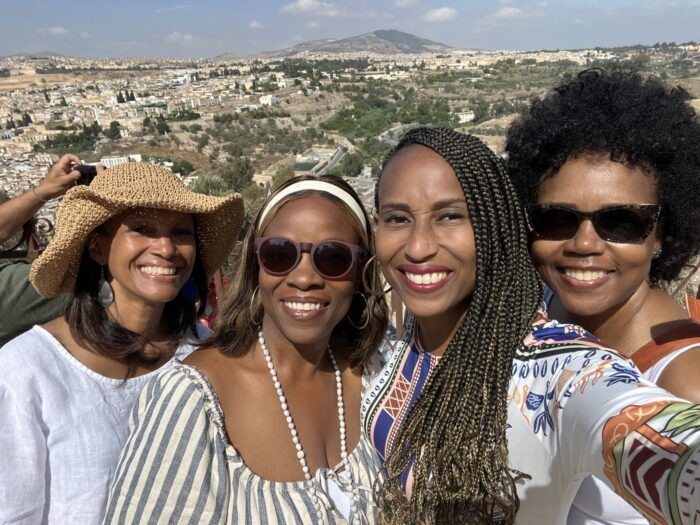 Aerial view of Marrakech Menara Airport, showcasing the modern architecture and bustling activity of one of Morocco's major international gateways.
Aerial view of Marrakech Menara Airport, showcasing the modern architecture and bustling activity of one of Morocco's major international gateways.
- By Ferry: You can also reach Morocco by ferry from Spain. The ferry trip can range from 1.5 hours to 36 hours, depending on the route. The fastest routes are from Algeciras and Tarifa in Spain to Tangier in Morocco, taking about 60-90 minutes. If you’re traveling with a car, ferries can accommodate vehicles, but it requires extra planning.
3. What Are The Best Ways To Get Around Morocco?
Once you arrive, knowing how to navigate the country is crucial for a smooth trip.
3.1 Trains
Morocco’s rail network is a comfortable and reliable option for traveling between major northern cities. Trains are generally on time and offer affordable rates.
3.2 Buses
Several public and private bus companies operate throughout Morocco, connecting cities across the country. However, buses can be slow and sometimes overcrowded.
3.3 Taxis
Taxis are a common mode of transport in Moroccan cities.
- Petit Taxis: These smaller vehicles can carry up to three passengers and are ideal for getting around within cities.
- Grand Taxis: Larger vehicles that accommodate up to six passengers. They are often used for traveling between cities.
While Uber is not available in Morocco, the “Careem” app operates in some major cities. In Marrakech, you can use taxi apps like “Heetch” and “Roby”. Hotels and Riads can also arrange car services with drivers for you.
3.4 Planes
For long distances between major cities, consider domestic flights. Royal Air Maroc and Air Arabia Maroc are the two domestic airlines offering these services.
4. What Is The Best Time Of Year To Visit Morocco?
The best time to visit Morocco is during the spring and fall, specifically from March to May and September to November. During these months, the weather is pleasant, avoiding the extreme heat of summer and the cooler temperatures of winter. Additionally, these periods are outside the peak tourist season, allowing for a more relaxed experience.
4.1 Planning Around Religious Holidays: Ramadan
Morocco’s official religion is Islam, and while most religious holidays won’t significantly affect your travel plans, Ramadan is an exception. Ramadan typically lasts 30 days, occurring between March and May. During this time, Muslims abstain from food and drink from dawn until sunset.
Many local restaurants and cafes may be closed during the daytime, which can impact your dining options. However, experiencing Morocco during Ramadan can be rewarding, with vibrant celebrations and unique cultural experiences after sunset.
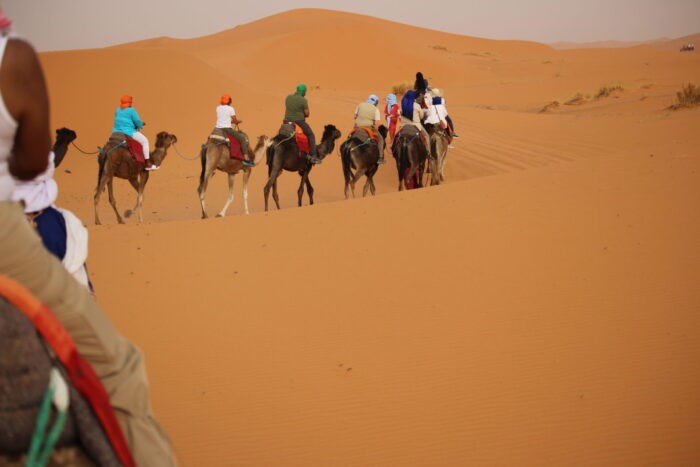 Evening celebration in Morocco during Ramadan, showing people gathering to enjoy food and festivities after sunset.
Evening celebration in Morocco during Ramadan, showing people gathering to enjoy food and festivities after sunset.
4.2 Seasons And Weather In Morocco
- Northern Cities (Casablanca, Tangier): These cities have a Mediterranean climate, with average summer temperatures around 73°F (23°C) and winter temperatures around 55°F (13°C). The sea breeze helps to cool the area, even in the summer.
- Central and Southern Cities (Fes, Marrakech): These cities can become very hot in the summer, with average temperatures in Marrakech reaching the 90s and sometimes exceeding 100°F. The average winter temperature is 54°F (12°C).
- Rainfall: Most of Morocco’s rainfall occurs from November to March, particularly in coastal regions.
5. What Languages Are Spoken In Morocco?
Morocco has two official languages: Modern Standard Arabic and Standard Moroccan Berber. However, the most commonly spoken languages are Moroccan Arabic (a dialect of Modern Standard Arabic) and various dialects of Moroccan Berber. French is also widely spoken due to Morocco’s history as a French protectorate.
5.1 Is English Widely Spoken In Morocco?
While English is not widely spoken, most people working in the tourism industry have a basic command of English. Learning a few basic phrases in Arabic or French can enhance your interactions and experiences.
6. What Currency Is Used In Morocco?
The currency in Morocco is the Moroccan Dirham (MAD). Many establishments prefer or only accept cash, so it’s a good idea to withdraw Dirhams from an ATM upon arrival. ATMs generally offer decent exchange rates. Credit cards are accepted in most restaurants and main shops, but smaller shops in the souks (markets) usually require cash. It’s also wise to have cash for tipping.
7. How Should I Dress When Visiting Morocco?
When visiting Morocco, it’s advisable to dress modestly, respecting local customs.
- Women: It’s recommended to wear tops that cover your chest and shoulders, and lightweight pants, shorts, or long dresses/skirts that cover your knees. Shoulders, chest, and knees should be covered, especially when visiting mosques. While head coverings are not typically required, carrying a scarf is a good idea just in case. Dress codes in Marrakech tend to be more casual.
- Men and Women: Shoes must be removed when entering mosques. Bring a bag to carry your shoes.
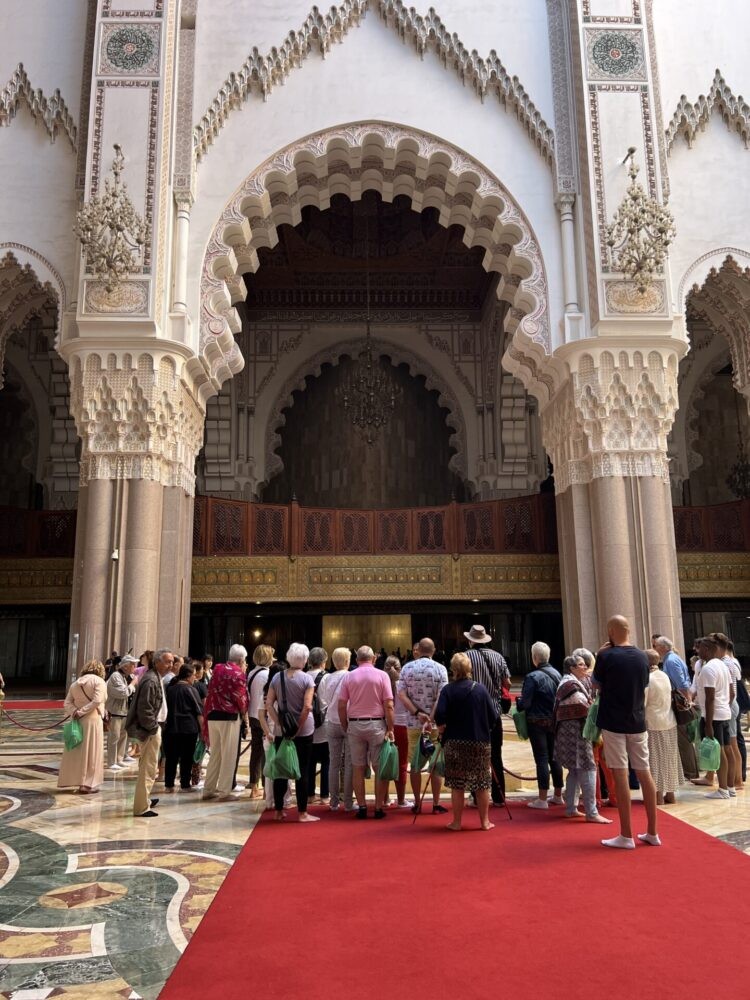 Woman in Casablanca at Hassan II Mosque, dressed modestly with covered shoulders and bare feet, carrying shoes in a green bag.
Woman in Casablanca at Hassan II Mosque, dressed modestly with covered shoulders and bare feet, carrying shoes in a green bag.
8. What Are The Best Places To Stay In Morocco?
When exploring Moroccan cities, consider staying in a Riad. A Riad is a traditional Moroccan house or palace with an interior garden or courtyard, now often converted into hotels or guesthouses. Riads offer a unique and authentic experience with beautiful architecture and convenient locations within the Medinas.
For a quieter experience, consider hotels and resorts located outside the Medina. Always check reviews to ensure a comfortable stay.
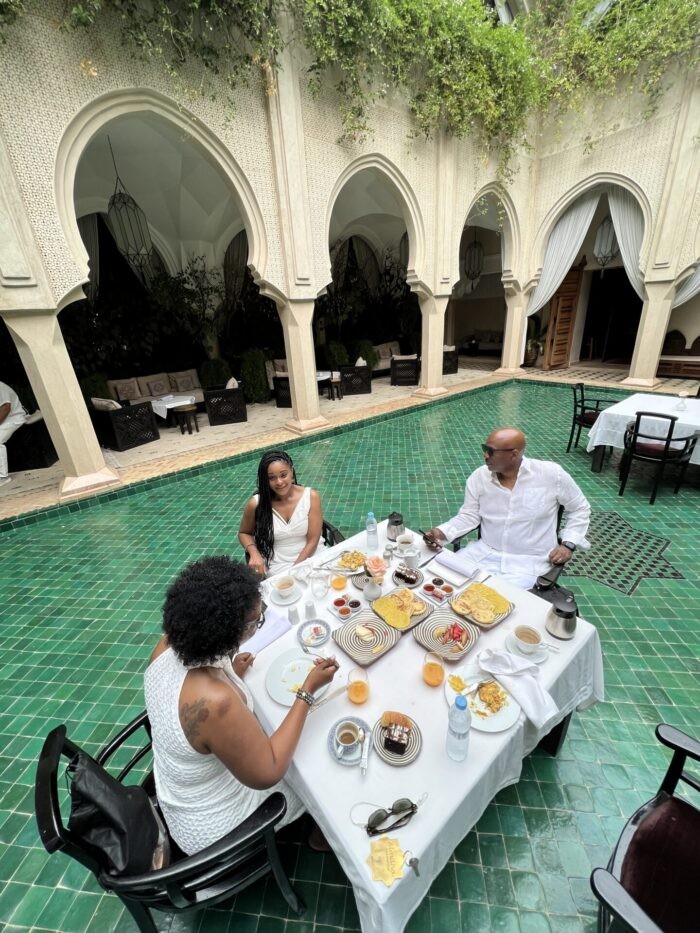 Interior of Riad Almaha in Morocco, showcasing its stunning architecture and tranquil courtyard garden.
Interior of Riad Almaha in Morocco, showcasing its stunning architecture and tranquil courtyard garden.
9. Where To Go & What To Do In Morocco?
Morocco offers a diverse range of attractions, from bustling medinas to serene desert landscapes. Here are some top destinations and activities:
9.1 Casablanca
Casablanca, while not the official capital, is a bustling modern city with historical touches.
-
Hassan II Mosque: One of the largest mosques in the world and one of the few open to non-Muslims.
-
Mohamed V Square: A central hub where locals gather, offering a joyful atmosphere and local vendors.
-
The Museum of Moroccan Judaism: Showcasing the 2,000-year history of the Jewish community in Morocco.
9.2 Fes
Fes is an ancient and historic city with narrow streets leading through bustling Medinas and majestic mosques.
- The Royal Palace: Admire the stunning seven front gates of the palace built in the 1960s.
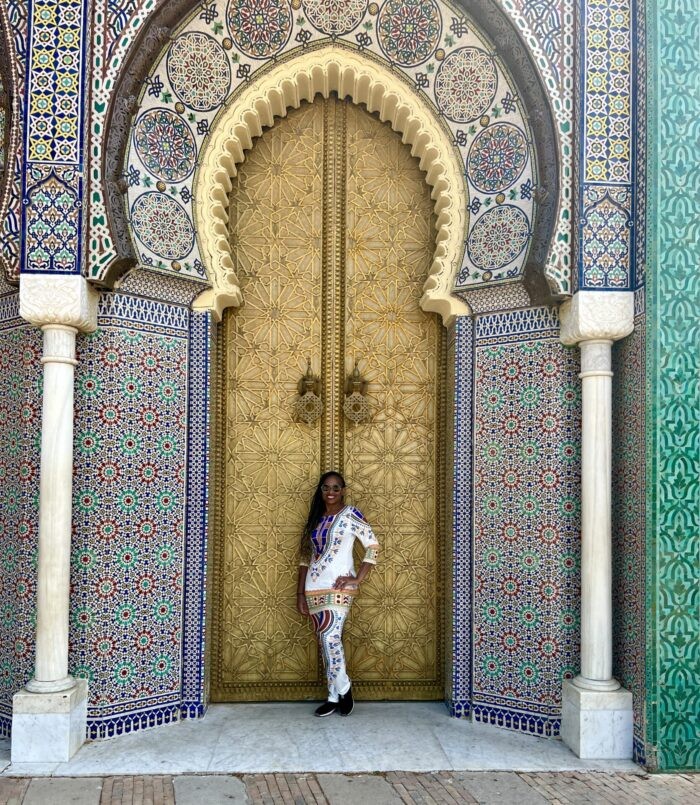 Ornate doors of the Royal Palace in Fes, showcasing intricate craftsmanship and design.
Ornate doors of the Royal Palace in Fes, showcasing intricate craftsmanship and design.
-
Jewish Cemetery: A historic cemetery established in 1883, featuring uniquely shaped white tombs.
-
Madrasa Bou Inania: A 14th-century Muslim learning institute with beautiful architecture.
-
Borj Nord: A fort housing the Museum of Arms, with thousands of historical pieces.
-
The Medina: One of the most expansive historic districts in the country, offering an authentic Moroccan experience. Be cautious due to the crowded and winding streets.
-
Chouara Tanneries: Witness the dyeing of animal skins and hides. Be prepared for a strong smell and the possibility of being asked for tips.
 The Medina in Fes, capturing its narrow streets, bustling activity, and historic architecture.
The Medina in Fes, capturing its narrow streets, bustling activity, and historic architecture.
9.3 Merzouga
Merzouga is a tranquil town in the Sahara Desert, serving as a gateway to Erg Chebbi sand dunes.
- Glamping in the Merzouga Desert: Experience a starlit sky free from light pollution. Enjoy camel rides, sandboarding, and live music around a fire.
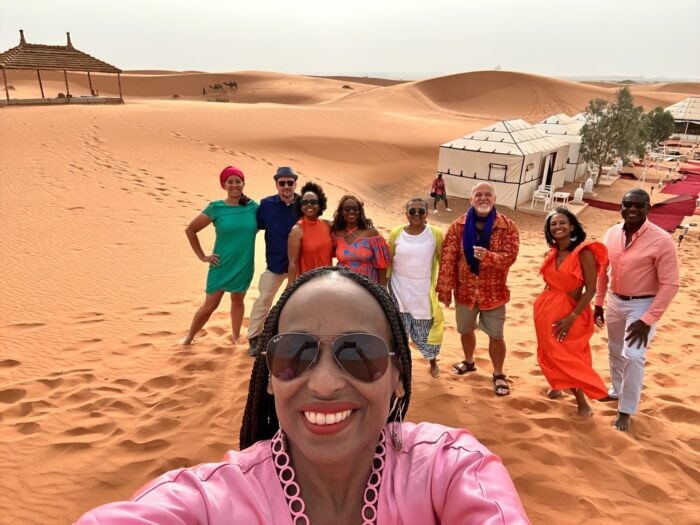 Group photo at a glamping site in the Sahara Desert, showcasing colorful outfits and the expansive desert landscape.
Group photo at a glamping site in the Sahara Desert, showcasing colorful outfits and the expansive desert landscape.
- Hike to the highest dune in Erg Chebbi: A challenging but rewarding experience.
- Dayet Srji: A salt lake attracting migratory birds like flamingos.
9.4 Dades Valley/Dades Gorge
Nestled in the Atlas Mountains, Dades Valley offers stunning landscapes.
-
Auberge Chez Pierre Hotel: A lovely hotel in Boumalne Dades, offering luxury at an affordable price.
-
Explore Dades Valley: Discover towering cliffs and fertile gardens.
-
Rose Valley and Kelaat M’Gouna: Immerse yourself in Morocco’s Berber culture.
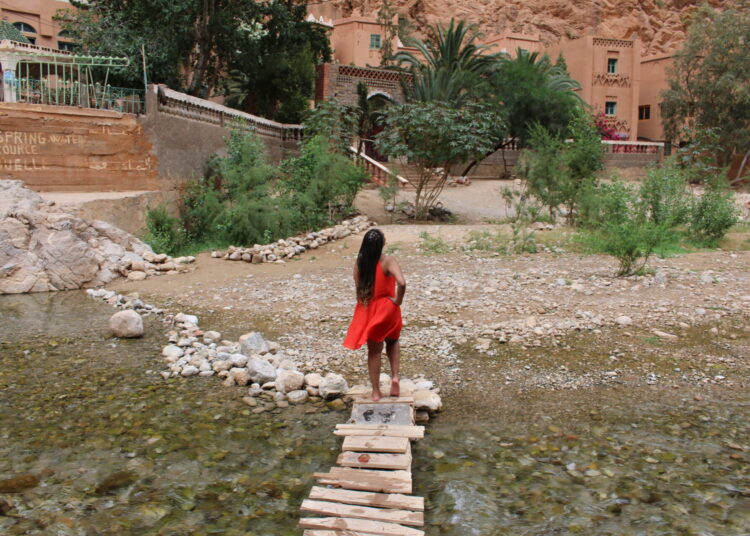 Scenic view of Dades Gorge, showcasing its towering cliffs and rugged landscape.
Scenic view of Dades Gorge, showcasing its towering cliffs and rugged landscape.
9.5 Marrakech
Marrakech blends tradition and modernity, considered the major city of Central Morocco.
-
Koutoubia Mosque: The largest mosque in Marrakech, known as “Mosque of the Booksellers”.
-
Jemaa el-Fnaa: A bustling square with street performers, musicians, and food stalls.
-
Bahia Palace: An opulent palace with tranquil courtyards and lush gardens.
-
Jardin Majorelle: A lush botanical garden with groves of bamboo and a Berber Museum. The “Majorelle Blue” is a must-see.
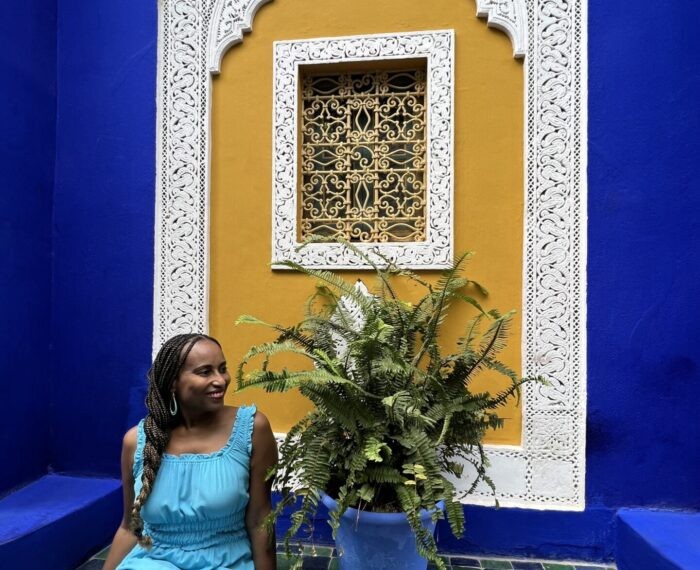 Woman at Majorelle Jardin, surrounded by lush greenery and the iconic "Majorelle Blue" accents.
Woman at Majorelle Jardin, surrounded by lush greenery and the iconic "Majorelle Blue" accents.
- YSL Museum: Exhibits of Yves Saint Laurent’s work, featuring garments, accessories, and sketches.
- Hotel La Maison Arabe: Offers Tagine cooking classes and Hammam spa treatments.
- Jnane Tamsna: A Black, woman-owned hotel with a lovely rooftop setting for cocktails and dinner.
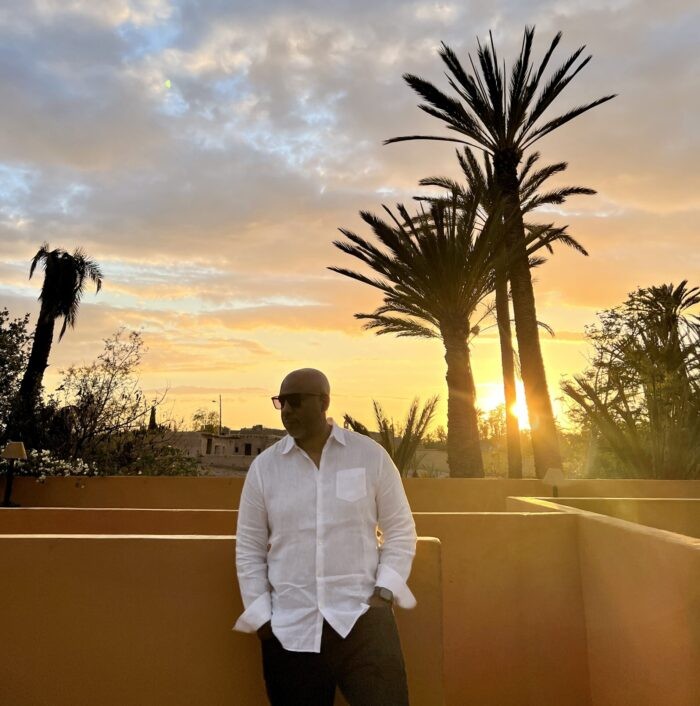 Sunset view from the rooftop of Jnane Tamsna in Marrakech, capturing the vibrant colors and Moroccan ambiance.
Sunset view from the rooftop of Jnane Tamsna in Marrakech, capturing the vibrant colors and Moroccan ambiance.
10. What Traditional Foods & Beverages Should I Try In Morocco?
Moroccan cuisine is aromatic, full of spices, and incredibly flavorful. Trying local dishes is a must for any traveler.
- Couscous: Morocco’s national dish, traditionally served with meat and vegetables.
- Harira: A soup made from tomatoes, lentils, chickpeas, and lamb, often served during Ramadan.
- R’fissa: A Casablanca specialty made with flaky pancakes, chicken in onion broth, herbs, and spices.
- Tanjia: Lamb or veal prepared in a terracotta jar, resulting in tender meat.
- Tagine: Dishes cooked in a clay pot, typically with slow-cooked meat, vegetables, herbs, and spices.
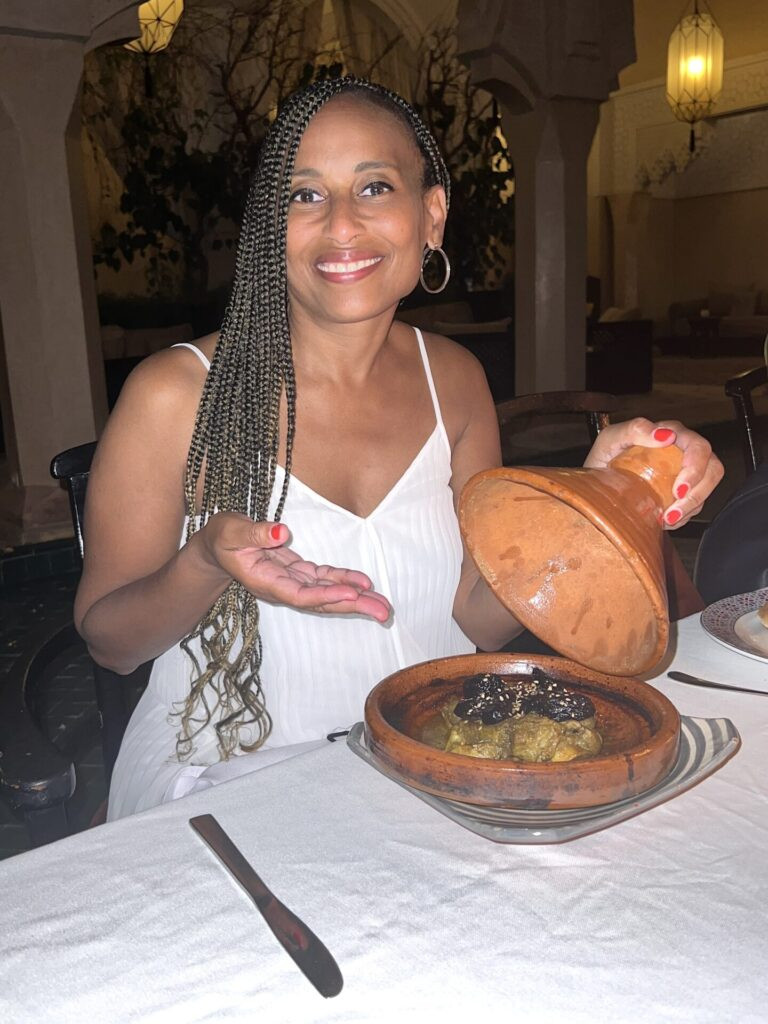 Tagine meal, featuring beef with prunes in a traditional clay pot.
Tagine meal, featuring beef with prunes in a traditional clay pot.
- Pastilla: A savory meat pie with a poultry or seafood filling, featuring sweet and savory flavors.
- Zalouk: A popular spread made of eggplants, garlic, tomatoes, olive oil, and spices, served with bread.
- Gazelle Horns: Moroccan cookies with an almond and orange blossom filling.
- Chebakia: A honey-dipped fried sesame cookie in the shape of a flower.
- Msemen: Flatbread eaten for breakfast and as street food, served sweet or savory.
- Baghrir: Pancakes known as “thousand hole pancakes,” commonly eaten for breakfast.
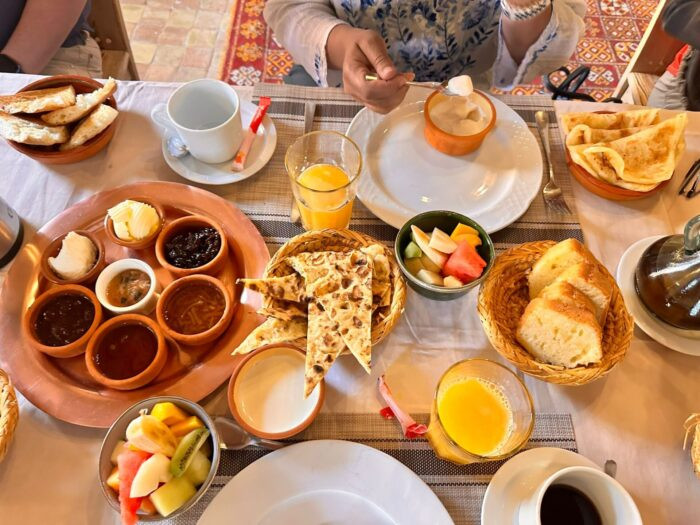 Typical Moroccan breakfast, featuring an assortment of pancakes, pastries, and fruits.
Typical Moroccan breakfast, featuring an assortment of pancakes, pastries, and fruits.
- Mint Tea: The most popular beverage in Morocco, made with fresh mint and sugar.
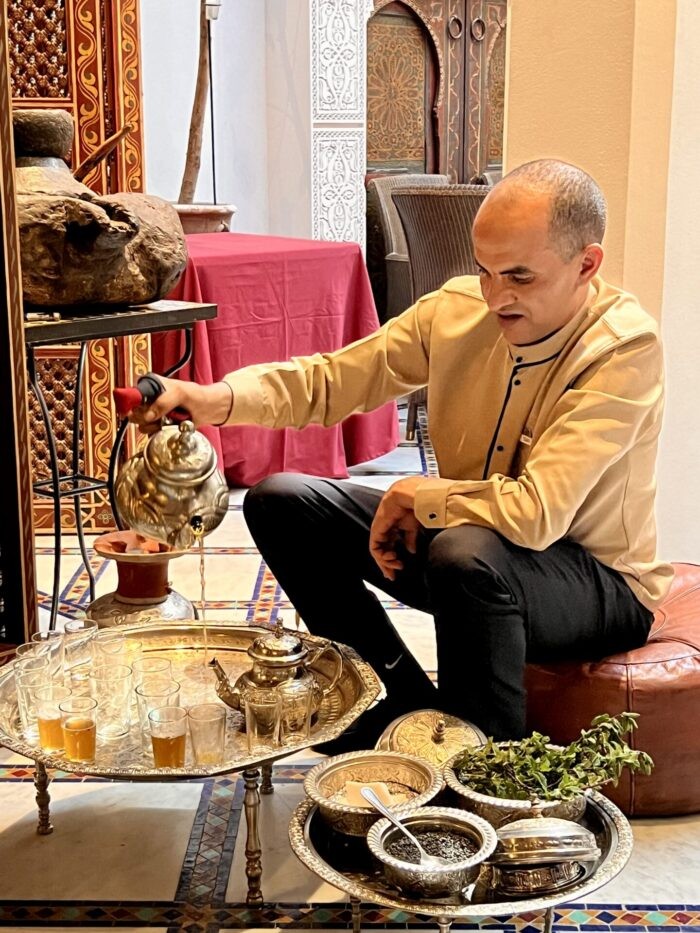 Mint tea being made during a cooking class, showcasing the traditional preparation process.
Mint tea being made during a cooking class, showcasing the traditional preparation process.
11. What Are The Best Souvenirs To Buy In Morocco?
Shopping in Morocco is an experience in itself, offering a wide array of unique and beautiful items.
- Leather Goods: High-quality leather items such as bags, shoes, and jackets.
- Home Goods: Pottery, furniture, mirrors, and other decorative items.
- Jewelry: Traditional Moroccan jewelry.
- Clothing: Locally made clothing items.
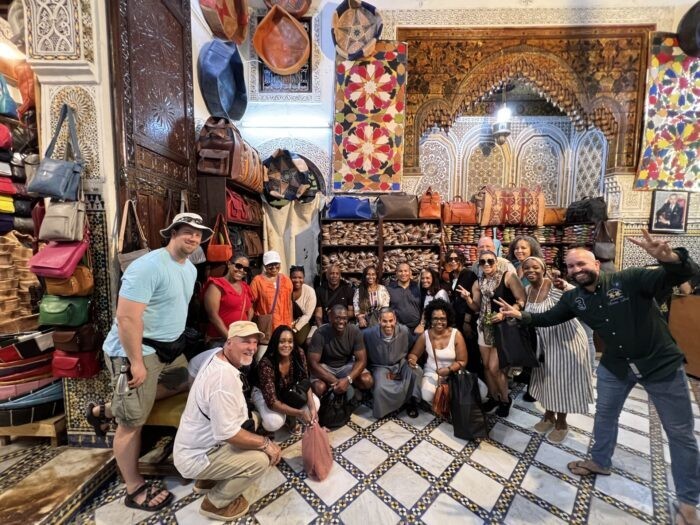 Group in a leather shop, showcasing the variety of leather goods available for purchase.
Group in a leather shop, showcasing the variety of leather goods available for purchase.
12. FAQ about Traveling to Morocco
12.1 What is the best way to plan a trip to Morocco?
Planning a trip to Morocco involves considering the best time to visit (spring or fall), arranging transportation (flights, trains, or ferries), and deciding on accommodations (Riads or hotels). Researching key destinations like Casablanca, Fes, Marrakech, and Merzouga helps tailor your itinerary to your interests.
12.2 Is it safe to travel to Morocco?
Yes, Morocco is generally safe for tourists. However, it’s important to stay aware of your surroundings, especially in crowded areas like markets and tourist spots. Avoid displaying expensive jewelry or electronics, and be cautious when walking alone at night.
12.3 What are the must-see attractions in Morocco?
Must-see attractions in Morocco include the Hassan II Mosque in Casablanca, the Medina in Fes, the Sahara Desert in Merzouga, Dades Valley, and Jemaa el-Fnaa square and Jardin Majorelle in Marrakech.
12.4 What should I pack for a trip to Morocco?
Pack lightweight, modest clothing suitable for a range of temperatures, comfortable walking shoes, sunscreen, a hat, and sunglasses. A scarf can be useful for covering your head in religious sites or protecting yourself from the sun. Don’t forget any necessary medications and a basic first-aid kit.
12.5 Do I need to know Arabic or French to travel in Morocco?
While knowing Arabic or French can enhance your experience, it’s not essential. Many people working in the tourism industry speak English. Learning a few basic phrases in Arabic or French can be helpful and appreciated by locals.
12.6 What is the best way to experience the Sahara Desert in Morocco?
The best way to experience the Sahara Desert is through a guided tour from Merzouga. These tours often include camel rides, overnight stays in desert camps (glamping), sandboarding, and cultural experiences with local Berber communities.
12.7 Can I drink alcohol in Morocco?
Alcohol is available in Morocco, particularly in larger cities and tourist areas. Many hotels, restaurants, and bars serve alcohol. However, it’s less common in smaller towns and rural areas, and it’s important to be respectful of local customs, especially during Ramadan.
12.8 What is the best way to get around Moroccan cities?
The best way to get around Moroccan cities is by using taxis (petit taxis for short distances and grand taxis for longer trips), buses, or, in some cities, apps like Careem, Heetch, and Roby. Walking is also a great way to explore the medinas, but be prepared for crowded streets and getting lost.
12.9 What is a Riad, and why should I stay in one?
A Riad is a traditional Moroccan house or palace with an interior garden or courtyard. Staying in a Riad offers a unique and authentic experience with beautiful architecture, tranquil settings, and convenient locations within the medinas. Riads often provide a more intimate and personalized experience compared to larger hotels.
12.10 Are credit cards widely accepted in Morocco?
Credit cards are accepted in many restaurants, hotels, and larger shops, but smaller shops, local markets, and some establishments in rural areas may only accept cash. It’s a good idea to carry a mix of cash and credit cards when traveling in Morocco.
13. SIXT.VN: Your Partner For Unforgettable Moroccan Adventure
Planning a trip to Morocco can be overwhelming, but SIXT.VN is here to help. From airport transfers and hotel bookings to guided tours and travel advice, we offer a range of services to make your trip seamless and stress-free.
- Personalized Itineraries: Tailored to your interests and preferences.
- Reliable Airport Transfers: Ensuring a smooth start and end to your journey.
- Handpicked Accommodations: Featuring the best Riads and hotels.
- Expert-Led Tours: Discovering hidden gems and cultural treasures.
Don’t let the challenges of planning hold you back. With SIXT.VN, you can experience the best of Morocco with ease and confidence.
Address: 260 Cau Giay, Hanoi, Vietnam
Hotline/Whatsapp: +84 986 244 358
Website: SIXT.VN
Ready to explore the magic of Morocco? Contact SIXT.VN today and let us help you create the adventure of a lifetime!



